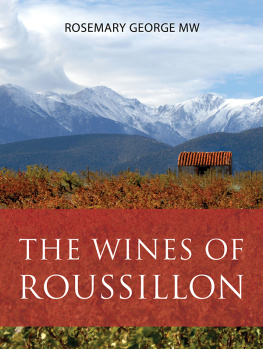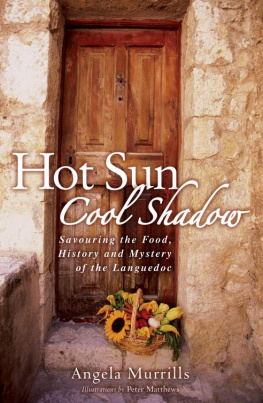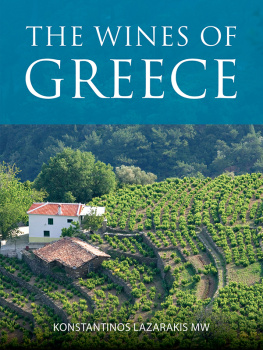THE INFINITE IDEAS CLASSIC WINE LIBRARY
Editorial board: Sarah Jane Evans MW and Richard Mayson
There is something uniquely satisfying about a good wine book, preferably read with a glass of the said wine in hand. The Infinite Ideas Classic Wine Library is a series of wine books written by authors who are both knowledgeable and passionate about their subject. Each title in The Infinite Ideas Classic Wine Library covers a wine region, country or type and together the books are designed to form a comprehensive guide to the world of wine as well as an enjoyable read, appealing to wine professionals, wine lovers, tourists, armchair travellers and wine trade students alike.
Port and the Douro , Richard Mayson
Cognac: The story of the worlds greatest brandy , Nicholas Faith
Sherry , Julian Jeffs
Madeira: The islands and their wines , Richard Mayson
The wines of Austria , Stephen Brook
Biodynamic wine , Monty Waldin
The story of champagne , Nicholas Faith
The wines of Faugres , Rosemary George MW
Cte dOr: The wines and winemakers of the heart of Burgundy ,
Raymond Blake
The wines of Canada , Rod Phillips
Ros: Understanding the pink wine revolution , Elizabeth Gabay MW
Amarone and the fine wines of Verona , Michael Garner
The wines of Greece , Konstantinos Lazarakis MW
Wines of the Languedoc , Rosemary George MW
The wines of northern Spain , Sarah Jane Evans MW

Rosemary George MW was lured into the wine trade by a glass of the Wine Societys champagne at a job interview and subsequently became one of the first women to become a Master of Wine, back in 1979. She has been a freelance wine writer since 1981 and is the author of twelve books, including French Country Wine , which first took her to the south of France. Back in the mid-1980s she realized that this was a region of enormous potential and consequently went on to write The Wines of the South of France (2001). This was the beginning of her enthusiasm for the Languedoc, which she has followed up most recently with The wines of Faugres . President of the Circle of Wine Writers, she writes a blog on the region (www.tastelanguedoc.blogspot.com) and contributes to various magazines such as Decanter and Sommelier India .
INTRODUCTION: SETTING THE SCENE
The first thing to do is to set the parameters. What is the Languedoc? So often it is lumped with Roussillon in the one breath of Languedoc-Roussillon, but in fact the two areas are separate and very different. Roussillon is Catalan; the Languedoc is French. Their history and traditions are not the same. Their original languages are different. Roussillon speaks Catalan; the Languedoc, Occitan. However, France has recently been amalgamating some of its regions, so that Occitanie, which you might think is the equivalent of the Languedoc, has been extended to become Languedoc-Midi-Pyrnes, with the regional capital shifting from Montpellier to Toulouse. However, for the purposes of this book, the Languedoc extends from the appellations of Malepre, Cabards and Limoux, to the west of Carcassonne, as far as the vineyards of Sommires and Pays des Cvennes, east of Montpellier.
In the west, the boundary is very clear cut. After the last vineyards of Cabards, the scenery gives way to the pastoral fields of the Lauragais, with sunflowers and wheat. No vines grow there. In the south, the departmental boundary of the Pyrnes-Orintales and the Aude separates Roussillon from the Languedoc and the vineyards of Corbires. The Terrasses du Larzac and the Pic St Loup are the most northern vineyards, with climate and geology placing a limit on the vineyards. Above them are the causses of the Larzac, sheep grazing country for Roquefort cheese. It is in the east that things become more blurred, and administrative geography comes into play. Although to my mind, Costires de Nimes is languedocien , French wine administration places it within the Rhne Valley. Likewise, the newest appellation of the area, Duch dUzs, opted to join the Rhne, even though it is more languedocien in approach, and the parallel IGP, Pays de Cvennes, is considered to be part of the Languedoc. Consequently, I have written about the Pays des Cvennes, but only mention the Duch dUzs in passing and Costires de Nimes not at all.
I have been visiting the Languedoc regularly for over 30 years, researching previous books, French Country Wines and then The Wines of the South of France, from Banyuls to Bellet . My visits became much more frequent after we bought a maison scondaire outside the historic town of Pzenas. You could say that it was the many visits to the area for the second book that enabled us to ascertain exactly which part of the south of France appealed the most. Faugres is our nearest appellation, so that seemed the natural choice for my next book (published in 2016), and now this one is the logical corollary.
Why write about the Languedoc now? Quite simply, and without exaggeration, it is the most exciting wine region of the whole of France. The pace of change in the past few years has been breathtaking, and for that reason I have chosen to concentrate on the Languedoc of the twenty-first century and on the new wine growers who are behind those changes. In a nutshell, the region has become, in the words of one grower, more confident, while another suggested wiser and more grown up. It is not only that work in the vineyard and cellar has improved dramatically but also that the atmosphere has changed, with a buoyancy and optimism apparent. While there are still problems, and indeed dull wines, there is now an underlying realization that the Languedoc has so much to offer. The lure of the Languedoc for outsiders, and newcomers to wine, is very strong. Many of the new producers say that it was more welcoming than other regions they explored. The newcomers have brought ideas from elsewhere and that all adds to a vibrant melting pot of dynamic attitudes, with an extraordinary enthusiasm and energy amongst the wine growers. I have lost count of the times somebody said: Cest ma passion . Life may be hard, with vineyards affected by frost, hail or drought, but they simply could not imagine doing anything else, and they are all making the very best wine they can. They enjoy the liberty that the Languedoc offers; if you make an appellation, you must conform to its regulations, but if you make an IGP, the rules are much more flexible, and if you make Vin de France, the restrictions are minimal. For this reason, the Languedoc is a hotbed of experimentation, with a wonderful choice of grape varieties. The appellations retain the established varieties but the producers of IGP and Vin de France may experiment virtually to their hearts content; some indeed make all three.
While I have been visiting the Languedoc regularly for the past thirty years this book is essentially the fruit of cellar visits between July 2016 and October 2017. I have enjoyed every moment, well almost every moment. It has taken me off the beaten track of the Languedoc, with so much to discover. I love the scenery. The hills of the Corbires are wild and rugged, dominated by the Montagne dAlaric and Mont Tauch. The Minervois has the backdrop of the Montagne Noire, which does indeed appear black in the distance. As you travel east, you encounter more distinctive skylines: the Caroux, or la femme allonge , dominates the vineyards of St Chinian; Faugres lies at the foot of the Espinouse; and Cabrires nestles underneath the dramatic Pic de Vissou. Driving south down the motorway, the A75, that runs through the centre of France, there is a moment when you come over the Pas de lEscalette and it seems that the whole Languedoc opens up before you. You can almost see the sparkle of the blue Mediterranean on the horizon, with a pimple that is the Mont Sainte Clair, outside Ste. Driving out of Aniane one can follow the Hrault up through winding gorges to the village of St Jean de Buges, past the Pont du Diable; or walk up in the vineyards above Montpeyroux where you have views of Mont Saint-Baudile, known as la Sentinelle du Larzac. Further east, the scenery is dominated by the two peaks of the Pic St Loup and the Montagne de lHortus, and to the east of Montpellier, the land becomes softer, with gentle undulating hills, and then you reach the Cvennes, with its national park, and more off the beaten track villages around Anduze, while down on the coast there are the lagoons, with their oyster beds, and the Mediterranean beyond.
Next page














